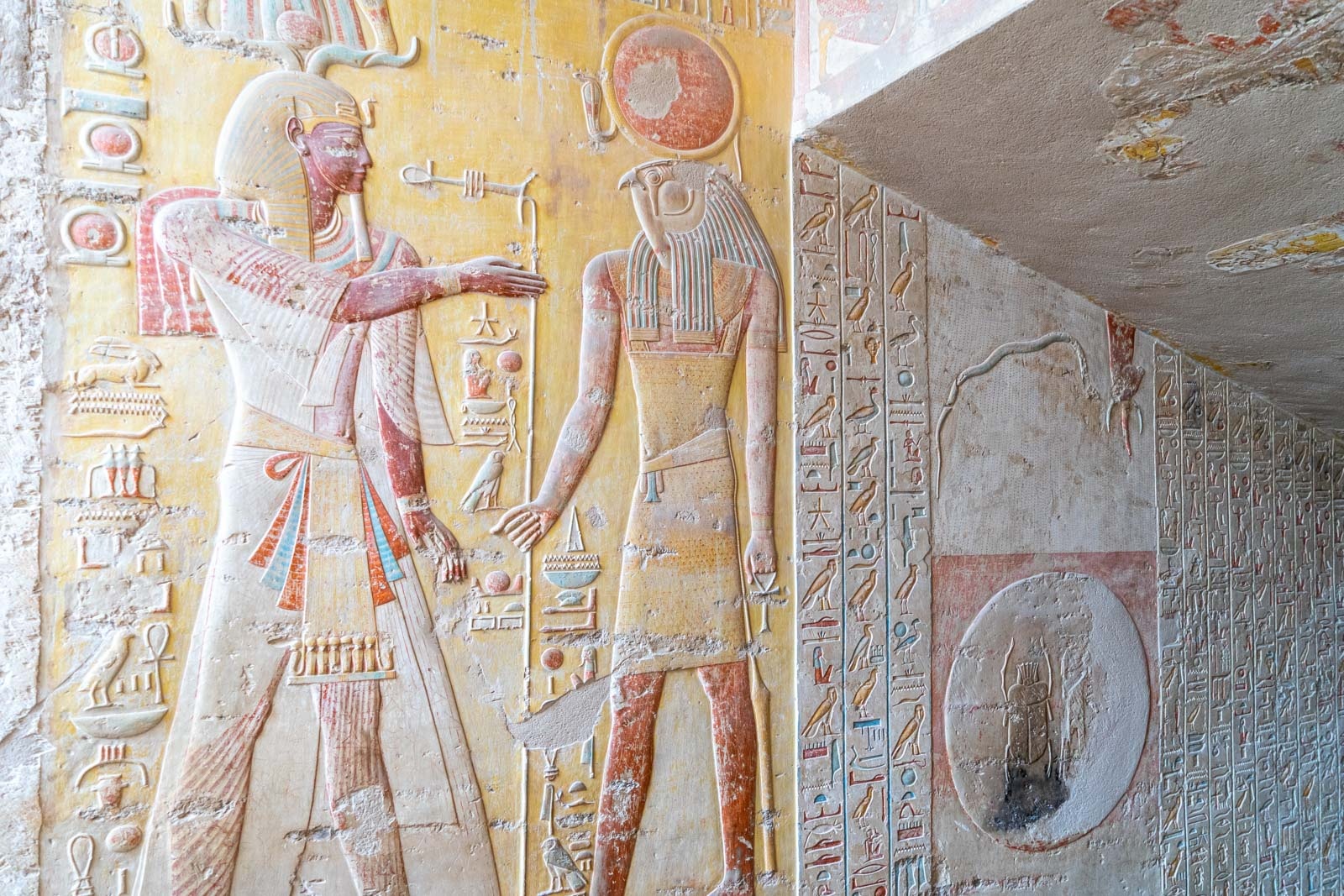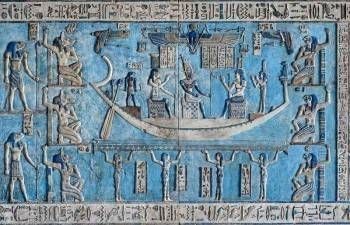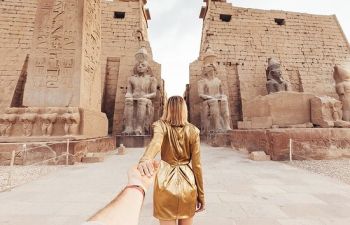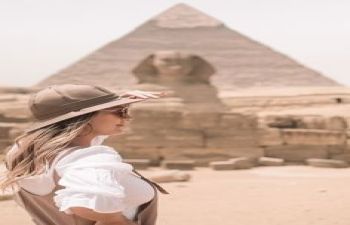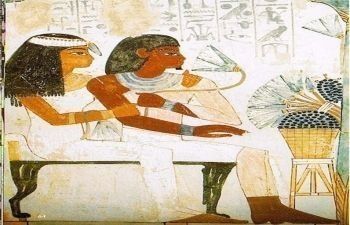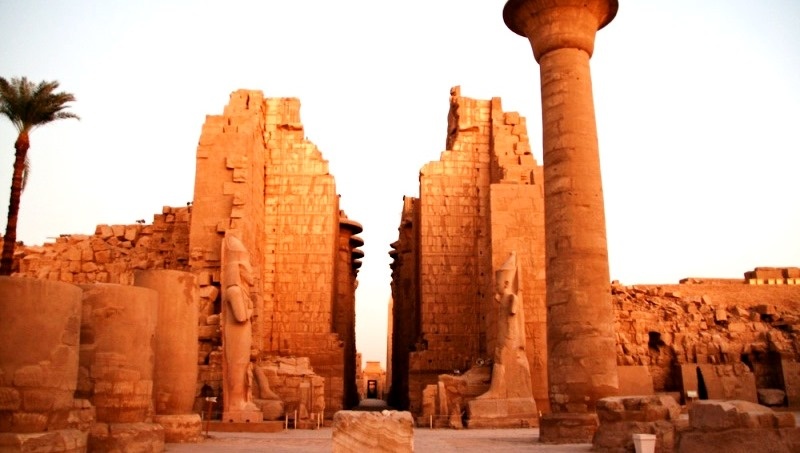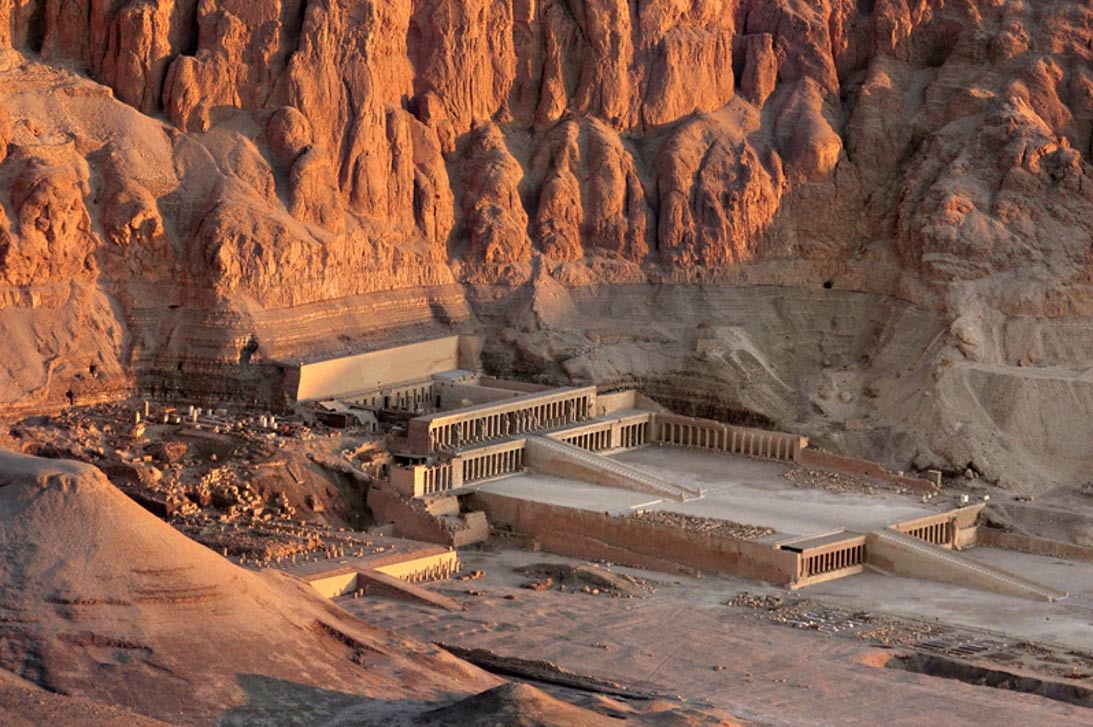Valley of the Kings
The west bank of Luxor had been the site of royal burials since around 2100 BC, but it was the pharaohs of the New Kingdom period (1550–1069 BC) who chose this isolated valley dominated by the pyramid-shaped mountain peak of Al Quran (The Horn). Once called the Great Necropolis of Millions of Years
Valley of the Kings
 TOMB OF RAMSES IV (2)
An ancient staircase with a ramp in the middle leads to the entrance of this tomb. Look on the lintel of the door to see Isis and Nephthys worshiping the sun, with the ram-headed sun god and a scarab depicted within. On the right-hand entrance wall, you can see two figures of Copts raising their hands in prayer. According to an inscription, one of them is "Apa Ammonios the martyr." The scenes and inscriptions were painted on stucco, almost all of which have fallen away. In the main chamber is the pharaoh's granite sarcophagus covered with inscriptions and reliefs.
TOMB OF RAMSES IV (2)
An ancient staircase with a ramp in the middle leads to the entrance of this tomb. Look on the lintel of the door to see Isis and Nephthys worshiping the sun, with the ram-headed sun god and a scarab depicted within. On the right-hand entrance wall, you can see two figures of Copts raising their hands in prayer. According to an inscription, one of them is "Apa Ammonios the martyr." The scenes and inscriptions were painted on stucco, almost all of which have fallen away. In the main chamber is the pharaoh's granite sarcophagus covered with inscriptions and reliefs.
 TOMB OF RAMSES IX (6)
This beautiful tomb has some excellent wall paintings. In the first corridor on the left-hand wall, you can see the pharaoh depicted in the presence of Harakhty and Osiris. Farther along, above the doors of two small undecorated chambers, is a text from the Praising of Re.
Just beyond the second chamber is a text from the 125th chapter of the Book of the Dead, which contains a declaration by the dead man of his freedom from sin. On the right-hand wall, the pharaoh is depicted in a chapel in the presence of Amun and the death goddess Meretseger. Above the doors of the side chambers are representations of snakes and dog- and bull-headed spirits, with an inscription giving the beginning of the "Sun God's Journey through the Underworld."
In the second corridor, look on the left to see a snake rearing up in a vertical position. To the right of this and in the niche are figures of gods (from the Praising of Re), while below the niche is the king, followed by the goddess Hathor. Beyond this, on the left, are texts from the Book of the Dead and then a scene of the pharaoh in the presence of the falcon-headed Khons-Neferhotep, with a falcon hovering over his head.The third corridor depicts the pharaoh presenting an image of Maat to Ptah, before whom the goddess herself is standing. Beyond this, you can see the pharaoh's resurrection (his mummy lying on a hill with his arms raised above his head), with a scarab and the sun above the mummy.From here, you enter the first chamber with its roof supported on four pillars. A short passage runs down to the tomb chamber, which contained the sarcophagus. On the wall are figures of gods and spirits. On the vaulted ceiling are two figures of the sky goddess, representing the morning and evening sky, while below her are constellations and stellar barques.Tomb of Ramses II (7)This tomb was plundered in antiquity, and the mummy was then removed to Deir el-Bahri. On both sides of the entrance corridor, in raised hieroglyphs, are texts from the Praising of Re. The scenes and inscriptions in low relief are badly damaged.
TOMB OF RAMSES IX (6)
This beautiful tomb has some excellent wall paintings. In the first corridor on the left-hand wall, you can see the pharaoh depicted in the presence of Harakhty and Osiris. Farther along, above the doors of two small undecorated chambers, is a text from the Praising of Re.
Just beyond the second chamber is a text from the 125th chapter of the Book of the Dead, which contains a declaration by the dead man of his freedom from sin. On the right-hand wall, the pharaoh is depicted in a chapel in the presence of Amun and the death goddess Meretseger. Above the doors of the side chambers are representations of snakes and dog- and bull-headed spirits, with an inscription giving the beginning of the "Sun God's Journey through the Underworld."
In the second corridor, look on the left to see a snake rearing up in a vertical position. To the right of this and in the niche are figures of gods (from the Praising of Re), while below the niche is the king, followed by the goddess Hathor. Beyond this, on the left, are texts from the Book of the Dead and then a scene of the pharaoh in the presence of the falcon-headed Khons-Neferhotep, with a falcon hovering over his head.The third corridor depicts the pharaoh presenting an image of Maat to Ptah, before whom the goddess herself is standing. Beyond this, you can see the pharaoh's resurrection (his mummy lying on a hill with his arms raised above his head), with a scarab and the sun above the mummy.From here, you enter the first chamber with its roof supported on four pillars. A short passage runs down to the tomb chamber, which contained the sarcophagus. On the wall are figures of gods and spirits. On the vaulted ceiling are two figures of the sky goddess, representing the morning and evening sky, while below her are constellations and stellar barques.Tomb of Ramses II (7)This tomb was plundered in antiquity, and the mummy was then removed to Deir el-Bahri. On both sides of the entrance corridor, in raised hieroglyphs, are texts from the Praising of Re. The scenes and inscriptions in low relief are badly damaged.
 TOMB OF MERNEPTAH (8)
The entrance corridors, with texts from the Praising of Re (on the left a very fine painted relief of the king before Re-Harakhty) and scenes from the Realm of the Dead (from the Book of the Gates), run fairly steeply down to an antechamber containing the granite lid of the outer coffin. From here, steps lead down to a three-aisled hypostyle hall with a barrel vault over the central aisle and flat roofs over the side aisles. In this chamber is the lid of the royal sarcophagus depicting a recumbent figure of the pharaoh. The lid, which as usual is in the form of a royal cartouche, is beautifully carved in pink granite. The carving of the pharaoh's face is particularly fine.
TOMB OF MERNEPTAH (8)
The entrance corridors, with texts from the Praising of Re (on the left a very fine painted relief of the king before Re-Harakhty) and scenes from the Realm of the Dead (from the Book of the Gates), run fairly steeply down to an antechamber containing the granite lid of the outer coffin. From here, steps lead down to a three-aisled hypostyle hall with a barrel vault over the central aisle and flat roofs over the side aisles. In this chamber is the lid of the royal sarcophagus depicting a recumbent figure of the pharaoh. The lid, which as usual is in the form of a royal cartouche, is beautifully carved in pink granite. The carving of the pharaoh's face is particularly fine.
 TOMB OF RAMSES VI (9)
This tomb, originally begun for Ramses V, is notable for the excellent preservation of its painted sunk reliefs (though they are inferior in style to those of the 19th Dynasty). Three corridors lead into an antechamber, beyond which is the first pillared chamber with which Ramses V's tomb ended. On the left-hand walls, you can see scenes of the sun's journey through the Underworld according to the Book of the Gates.Two corridors, with scenes from the sun god's journey through the Underworld according to the Book of what is in the Underworld, lead into another antechamber, the walls of which are covered with texts and scenes from the Book of the Dead. Beyond this is the second pillared chamber, still containing remnants of the great granite sarcophagus. On the walls are texts relating to the Underworld, while on the vaulted ceiling are two figures of the sky goddess, representing the day sky and the night sky, with the hours. The tomb contains numerous Greek and Coptic graffiti.
TOMB OF RAMSES VI (9)
This tomb, originally begun for Ramses V, is notable for the excellent preservation of its painted sunk reliefs (though they are inferior in style to those of the 19th Dynasty). Three corridors lead into an antechamber, beyond which is the first pillared chamber with which Ramses V's tomb ended. On the left-hand walls, you can see scenes of the sun's journey through the Underworld according to the Book of the Gates.Two corridors, with scenes from the sun god's journey through the Underworld according to the Book of what is in the Underworld, lead into another antechamber, the walls of which are covered with texts and scenes from the Book of the Dead. Beyond this is the second pillared chamber, still containing remnants of the great granite sarcophagus. On the walls are texts relating to the Underworld, while on the vaulted ceiling are two figures of the sky goddess, representing the day sky and the night sky, with the hours. The tomb contains numerous Greek and Coptic graffiti.
 TOMB OF RAMSES III (KV 11)
One of the most popular tombs in the valley, KV 11 is also one of the most interesting and best-preserved. Originally started by Sethnakht (1186–1184 BC), the project was abandoned when workers hit the shaft of another tomb (KV10). Work resumed under Ramses III (1184–1153 BC), the last of Egypt’s warrior pharaohs, with the corridor turning to the right, then left. It continues deep (125m overall) into the mountain and opens into a magnificent eight-pillared burial chamber. The wonderful decorations include colorful painted sunken reliefs featuring the traditional ritual texts (Litany of Ra, Book of Gates, etc) and Ramses before the gods. Unusual here is the secular scenes, in the small side rooms of the entrance corridor, showing foreign tributes, such as highly detailed pottery imported from the Aegean, the royal armory, boats and, in the last of these side chambers, the blind harpists that gave the tomb one of its alternative names: ‘Tomb of the Harpers’. When the Scottish traveler James Bruce included a copy of this image in his Travels to Discover the Source of the Nile, he was laughed out of London after its publication in 1790.
In the chamber beyond is an aborted tunnel where ancient builders ran into the neighboring tomb. They shifted the axis of the tomb to the west and built a corridor leading to a pillared hall, with walls decorated with scenes from the Book of Gates. There is also ancient graffiti on the rear right pillar describing the reburial of the pharaoh during the 21st dynasty (1069–945 BC). The remainder of the tomb is only partially excavated and structurally weak Ramses III’s sarcophagus is in the Louvre in Paris, its detailed lid is in the Fitzwilliam Museum in Cambridge and his mummy – found in the Deir Al Bahri cache – is now in Cairo’s Egyptian Museum. It was the model for Boris Karloff’s character in the 1930s film The Mummy.
TOMB OF RAMSES III (KV 11)
One of the most popular tombs in the valley, KV 11 is also one of the most interesting and best-preserved. Originally started by Sethnakht (1186–1184 BC), the project was abandoned when workers hit the shaft of another tomb (KV10). Work resumed under Ramses III (1184–1153 BC), the last of Egypt’s warrior pharaohs, with the corridor turning to the right, then left. It continues deep (125m overall) into the mountain and opens into a magnificent eight-pillared burial chamber. The wonderful decorations include colorful painted sunken reliefs featuring the traditional ritual texts (Litany of Ra, Book of Gates, etc) and Ramses before the gods. Unusual here is the secular scenes, in the small side rooms of the entrance corridor, showing foreign tributes, such as highly detailed pottery imported from the Aegean, the royal armory, boats and, in the last of these side chambers, the blind harpists that gave the tomb one of its alternative names: ‘Tomb of the Harpers’. When the Scottish traveler James Bruce included a copy of this image in his Travels to Discover the Source of the Nile, he was laughed out of London after its publication in 1790.
In the chamber beyond is an aborted tunnel where ancient builders ran into the neighboring tomb. They shifted the axis of the tomb to the west and built a corridor leading to a pillared hall, with walls decorated with scenes from the Book of Gates. There is also ancient graffiti on the rear right pillar describing the reburial of the pharaoh during the 21st dynasty (1069–945 BC). The remainder of the tomb is only partially excavated and structurally weak Ramses III’s sarcophagus is in the Louvre in Paris, its detailed lid is in the Fitzwilliam Museum in Cambridge and his mummy – found in the Deir Al Bahri cache – is now in Cairo’s Egyptian Museum. It was the model for Boris Karloff’s character in the 1930s film The Mummy.
 TOMB OF RAMSES I (16)
A sloping corridor and a steep staircase leading down to the tomb chamber, in the middle of which is the open red granite coffin of the king, with pictures and texts painted in yellow. The walls of the chamber are covered with colored scenes and inscriptions. On the entrance wall, look to the left to see Maat and Ramses I before Ptah. To the right, Maat and the pharaoh are making an offering to Nefertum, while behind is the symbolic knot of Isis. On the left-hand wall to the right of the door and above it are scenes from the third section of the Book of the Gates. First we see the gateway, guarded by a snake, then the journey through the third division of the Underworld. In the middle, the boat is being drawn by four men towards a long chapel in which are the mummies of nine gods.
TOMB OF RAMSES I (16)
A sloping corridor and a steep staircase leading down to the tomb chamber, in the middle of which is the open red granite coffin of the king, with pictures and texts painted in yellow. The walls of the chamber are covered with colored scenes and inscriptions. On the entrance wall, look to the left to see Maat and Ramses I before Ptah. To the right, Maat and the pharaoh are making an offering to Nefertum, while behind is the symbolic knot of Isis. On the left-hand wall to the right of the door and above it are scenes from the third section of the Book of the Gates. First we see the gateway, guarded by a snake, then the journey through the third division of the Underworld. In the middle, the boat is being drawn by four men towards a long chapel in which are the mummies of nine gods.
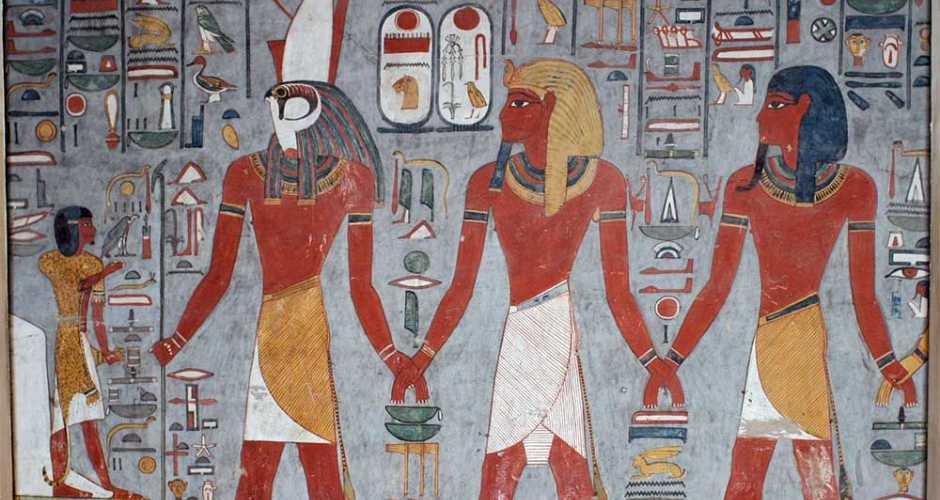 TOMB OF SETI I (17)
WALL PAINTING IN THE TOMB OF SETI I
One of the great achievements of Egyptian art, this cathedral-like tomb is the finest in the Valley of the Kings. Long closed to visitors, it is now reopened and if you can afford the ticket, it is money well spent. The 137m-long tomb was completely decorated and beautifully preserved when Giovanni Belzoni opened it in 1817, and although it has suffered since, it still offers an eye-popping experience – art from Seti's reign is among the finest in Egypt.
Seti I, who succeeded Ramses I and was the father of Ramses II, ruled some 70 years after the death of Tutankhamun
. After the chaos of the Akhenaten years at Tell Al Amarna, Seti I's reign was a golden age that saw a revival of Old Kingdom-style art, best seen at his temple in Abydos and here in his tomb. The tomb suffered after Belzoni made copies of the decoration by laying wet papers over the raised reliefs and lifting off some of the colors. Subsequent visitors did more damage, with Champollion, the man who deciphered hieroglyphs, even cutting out some of the wall decoration. The tomb was reopened in 2016 and its walls are filled with fabulous images from many ancient texts, including the Litany of Ra, Book of the Dead, Book of Gates, Book of the Heavenly Cow, and many others. The sarcophagus, one of the finest carved in Egypt and taken by Belzoni, now sits in the Sir John Soane's Museum, London, while two of its painted reliefs showing Seti with Hathor are now in the Louvre in Paris and Florence’s Archaeological Museum.
Scenes of the sun's journey through the fourth division of the Underworld (fourth part of the Book of the Gates) are depicted in the first pillared chamber. At the beginning is the fourth gateway, guarded by a snake, then, in the middle row, the solar barque drawn by four men, while in front of it are spirits with a coiled snake, three ibis-headed gods, and nine other gods ("the spirits of men who are in the Underworld").
From the first pillared chamber, a flight of 18 steps leads down by way of two corridors with representations of the "opening of the mouth" ceremony into an antechamber, with fine reliefs of the pharaoh in the presence of various gods of the dead. A short flight of steps leads into the second pillared chamber. The scenes and inscriptions in this room are merely sketched out in red and black on stucco. On the pillars, the pharaoh is depicted before various deities. The scenes on the rear wall show the sun's journey during the tenth hour of night (10th part of the Book of what is in the Underworld).
Beyond is the third pillared chamber, from which a ramp flanked by steps leads down to the mummy shaft. This consists of a front portion with six pillars and a rear portion with a vaulted roof, on a lower level. In the front section are scenes in the realm of the dead from the Book of the Gates. In the rear section was the pharaoh's alabaster sarcophagus, now in the Soane Museum in London. The king's mummy was found at Deir el-Bahri and is now in the Egyptian Museum in Cairo.
TOMB OF SETI I (17)
WALL PAINTING IN THE TOMB OF SETI I
One of the great achievements of Egyptian art, this cathedral-like tomb is the finest in the Valley of the Kings. Long closed to visitors, it is now reopened and if you can afford the ticket, it is money well spent. The 137m-long tomb was completely decorated and beautifully preserved when Giovanni Belzoni opened it in 1817, and although it has suffered since, it still offers an eye-popping experience – art from Seti's reign is among the finest in Egypt.
Seti I, who succeeded Ramses I and was the father of Ramses II, ruled some 70 years after the death of Tutankhamun
. After the chaos of the Akhenaten years at Tell Al Amarna, Seti I's reign was a golden age that saw a revival of Old Kingdom-style art, best seen at his temple in Abydos and here in his tomb. The tomb suffered after Belzoni made copies of the decoration by laying wet papers over the raised reliefs and lifting off some of the colors. Subsequent visitors did more damage, with Champollion, the man who deciphered hieroglyphs, even cutting out some of the wall decoration. The tomb was reopened in 2016 and its walls are filled with fabulous images from many ancient texts, including the Litany of Ra, Book of the Dead, Book of Gates, Book of the Heavenly Cow, and many others. The sarcophagus, one of the finest carved in Egypt and taken by Belzoni, now sits in the Sir John Soane's Museum, London, while two of its painted reliefs showing Seti with Hathor are now in the Louvre in Paris and Florence’s Archaeological Museum.
Scenes of the sun's journey through the fourth division of the Underworld (fourth part of the Book of the Gates) are depicted in the first pillared chamber. At the beginning is the fourth gateway, guarded by a snake, then, in the middle row, the solar barque drawn by four men, while in front of it are spirits with a coiled snake, three ibis-headed gods, and nine other gods ("the spirits of men who are in the Underworld").
From the first pillared chamber, a flight of 18 steps leads down by way of two corridors with representations of the "opening of the mouth" ceremony into an antechamber, with fine reliefs of the pharaoh in the presence of various gods of the dead. A short flight of steps leads into the second pillared chamber. The scenes and inscriptions in this room are merely sketched out in red and black on stucco. On the pillars, the pharaoh is depicted before various deities. The scenes on the rear wall show the sun's journey during the tenth hour of night (10th part of the Book of what is in the Underworld).
Beyond is the third pillared chamber, from which a ramp flanked by steps leads down to the mummy shaft. This consists of a front portion with six pillars and a rear portion with a vaulted roof, on a lower level. In the front section are scenes in the realm of the dead from the Book of the Gates. In the rear section was the pharaoh's alabaster sarcophagus, now in the Soane Museum in London. The king's mummy was found at Deir el-Bahri and is now in the Egyptian Museum in Cairo.
 TOMB OF TUTHMOSIS III (34)
The Tomb of Tuthmosis III is in a narrow and steep-sided gully some 250 meters south of the tomb of Ramses III. A sloping corridor down to a staircase with wide niches on the right and left, with a farther corridor beyond, leads to a square shaft five to six meters deep, probably intended to deter tomb robbers; it is now crossed by a footbridge. The roof has white stars on a blue background.
Beyond the shaft is a chamber with two pillars, and on the walls are lists of 741 different deities and demons. At the left-hand end of the rear wall, a staircase leads down to the tomb chamber, which has the oval shape of a royal cartouche. The ceiling, with yellow stars on a blue background, is supported on two square pillars.
The walls are covered with well-preserved scenes and texts from the Book of what is in the Underworld. Those on the pillars are of particular interest. On one side of the first pillar is a long religious text, while on the second side are Tuthmosis III and his mother in a boat (at the top) and the king suckled by his mother in the form of a tree (below).
The sarcophagus is of red sandstone with painted scenes and inscriptions. It was empty when the tomb was opened, but the mummy was found at Deir el Bahri. The grave goods from the four small side chambers are now in the Egyptian Museum in Cairo.
TOMB OF TUTHMOSIS III (34)
The Tomb of Tuthmosis III is in a narrow and steep-sided gully some 250 meters south of the tomb of Ramses III. A sloping corridor down to a staircase with wide niches on the right and left, with a farther corridor beyond, leads to a square shaft five to six meters deep, probably intended to deter tomb robbers; it is now crossed by a footbridge. The roof has white stars on a blue background.
Beyond the shaft is a chamber with two pillars, and on the walls are lists of 741 different deities and demons. At the left-hand end of the rear wall, a staircase leads down to the tomb chamber, which has the oval shape of a royal cartouche. The ceiling, with yellow stars on a blue background, is supported on two square pillars.
The walls are covered with well-preserved scenes and texts from the Book of what is in the Underworld. Those on the pillars are of particular interest. On one side of the first pillar is a long religious text, while on the second side are Tuthmosis III and his mother in a boat (at the top) and the king suckled by his mother in the form of a tree (below).
The sarcophagus is of red sandstone with painted scenes and inscriptions. It was empty when the tomb was opened, but the mummy was found at Deir el Bahri. The grave goods from the four small side chambers are now in the Egyptian Museum in Cairo.
 TOMB OF AMENOPHIS II (35)
From the entrance, steep flights of steps and sloping corridors descend to a shaft (now bridged over), at the foot of which is a small room, and beyond this, the first chamber (undecorated) with two pillars. At the left-hand end of the rear wall is a flight of steps leading down to a sloping corridor, at the end of which is the second chamber with six pillars. To the rear of this chamber, on a lower level, is a crypt. On the pillars, the king is depicted in the presence of the gods of the dead, while on the walls are finely executed scenes and texts from the Book of what is in the Underworld. In the crypt is the king's sandstone sarcophagus, in which the mummy of Amenophis II was found intact with a bunch of flowers and garlands. On each side are two chambers in which many mummies, no doubt brought here to be safe from tomb robbers, were found including those of Tuthmosis IV and Amenophis III (18th Dynasty) and Siptah and Seti II (19th Dynasty).
TOMB OF TUTANKHAMUN (62)
The discovery of the tomb of Tutankhamun
caused a sensation and raised the profile of Ancient Egypt with modern tourists and scholars. His tomb had been robbed at least twice before its discovery by Howard Carter but based on the items taken (including perishable oils and perfumes) and the evidence of restoration of the tomb it is likely that these robberies took place fairly soon after the pharaoh’s burial. The tomb was probably saved from further incursions because its entrance was buried under debris and chips of stone excavated during the construction of other tombs (in particular KV 9 the burial of Rameses VI) and washed there during the infrequent floods which occasionally swept the area. It also seems that worker’s accommodation was built above the location of the entrance during the Rameside period implying that the Egyptians themselves did not know there was a tomb beneath them.
Discovered by Howard Carter on November 4, 1922, the Tomb of Tutankhamun
is by far the Valley of the King's most famous tomb. Tutankhamun
was the son-in-law of Akhenaten and died (in circumstances unknown) in his 18th or 19th year.
A flight of 16 steps leads down to the entrance on the east side of the tomb. The doorway opens into a narrow passage, 7.5 meters long, and at the far end, another door gives access to an antechamber, the largest chamber in the tomb, which was found filled to overflowing with grave goods of all kinds. At the southwest corner (far left) is a side chamber. At the north wall, two life-size wooden statues of the pharaoh were found. In the middle of the chamber is the sarcophagus, of yellowish crystalline sandstone. Its sides are covered with religious scenes and texts, and at the corners are four relief figures of goddesses with wings protectively outspread. The pharaoh's mummy was contained within three richly decorated wooden coffins inside the sarcophagus.
On the east side of the tomb chamber is a small store room. On the walls of the chamber are painted scenes, rather hastily executed, showing Pharaoh Ay, Tutankhamun
's successor, performing the "opening of the mouth" ceremony on the mummy, and Tutankhamun
making offerings to various gods.
TOMB OF AMENOPHIS II (35)
From the entrance, steep flights of steps and sloping corridors descend to a shaft (now bridged over), at the foot of which is a small room, and beyond this, the first chamber (undecorated) with two pillars. At the left-hand end of the rear wall is a flight of steps leading down to a sloping corridor, at the end of which is the second chamber with six pillars. To the rear of this chamber, on a lower level, is a crypt. On the pillars, the king is depicted in the presence of the gods of the dead, while on the walls are finely executed scenes and texts from the Book of what is in the Underworld. In the crypt is the king's sandstone sarcophagus, in which the mummy of Amenophis II was found intact with a bunch of flowers and garlands. On each side are two chambers in which many mummies, no doubt brought here to be safe from tomb robbers, were found including those of Tuthmosis IV and Amenophis III (18th Dynasty) and Siptah and Seti II (19th Dynasty).
TOMB OF TUTANKHAMUN (62)
The discovery of the tomb of Tutankhamun
caused a sensation and raised the profile of Ancient Egypt with modern tourists and scholars. His tomb had been robbed at least twice before its discovery by Howard Carter but based on the items taken (including perishable oils and perfumes) and the evidence of restoration of the tomb it is likely that these robberies took place fairly soon after the pharaoh’s burial. The tomb was probably saved from further incursions because its entrance was buried under debris and chips of stone excavated during the construction of other tombs (in particular KV 9 the burial of Rameses VI) and washed there during the infrequent floods which occasionally swept the area. It also seems that worker’s accommodation was built above the location of the entrance during the Rameside period implying that the Egyptians themselves did not know there was a tomb beneath them.
Discovered by Howard Carter on November 4, 1922, the Tomb of Tutankhamun
is by far the Valley of the King's most famous tomb. Tutankhamun
was the son-in-law of Akhenaten and died (in circumstances unknown) in his 18th or 19th year.
A flight of 16 steps leads down to the entrance on the east side of the tomb. The doorway opens into a narrow passage, 7.5 meters long, and at the far end, another door gives access to an antechamber, the largest chamber in the tomb, which was found filled to overflowing with grave goods of all kinds. At the southwest corner (far left) is a side chamber. At the north wall, two life-size wooden statues of the pharaoh were found. In the middle of the chamber is the sarcophagus, of yellowish crystalline sandstone. Its sides are covered with religious scenes and texts, and at the corners are four relief figures of goddesses with wings protectively outspread. The pharaoh's mummy was contained within three richly decorated wooden coffins inside the sarcophagus.
On the east side of the tomb chamber is a small store room. On the walls of the chamber are painted scenes, rather hastily executed, showing Pharaoh Ay, Tutankhamun
's successor, performing the "opening of the mouth" ceremony on the mummy, and Tutankhamun
making offerings to various gods.
 TOMB OF HOREMHEB (KV 57)
Horemheb was Tutankhamun
's general, who succeeded Ay, Tutankhamun
's briefly reigning tutor. His tomb has beautiful decoration that shows the first use of bas-relief in the valley. This was also the first time the Book of Gates was used to decorate a tomb in the burial chamber. Some 128m long and very steep, this was also the first tomb to run straight and not have a right-angle bend. Horemheb, who was not of royal birth, ruled for 28 years and restored the cult of Amun.
This tomb was discovered filled with ransacked pieces of the royal funerary equipment, including a number of wooden figurines that were taken to the Egyptian Museum in Cairo. Horemheb (1323–1295 BC) brought stability after the turmoil of Akhenaten’s reign. He had already built a lavish tomb in Saqqara but abandoned it for this tomb. The various stages of decoration in the burial chamber give a fascinating glimpse into the process of tomb decoration.
From the entrance, a steep flight of steps and an equally steep passage lead to a well shaft decorated with superb figures of Horemheb before the gods. Notice Hathor’s blue-and-black striped wig and the lotus crown of the young god Nefertum, all executed against a grey-blue background. The six-pillared burial chamber, decorated with part of the Book of Gates, remains partially unfinished, showing how the decoration was applied by following a grid system in red ink over which the figures were drawn in black prior to their carving and painting. The pharaoh’s empty red-granite sarcophagus carved with protective figures of goddesses with outstretched wings remains in the tomb; his mummy is missing.
TOMB OF HOREMHEB (KV 57)
Horemheb was Tutankhamun
's general, who succeeded Ay, Tutankhamun
's briefly reigning tutor. His tomb has beautiful decoration that shows the first use of bas-relief in the valley. This was also the first time the Book of Gates was used to decorate a tomb in the burial chamber. Some 128m long and very steep, this was also the first tomb to run straight and not have a right-angle bend. Horemheb, who was not of royal birth, ruled for 28 years and restored the cult of Amun.
This tomb was discovered filled with ransacked pieces of the royal funerary equipment, including a number of wooden figurines that were taken to the Egyptian Museum in Cairo. Horemheb (1323–1295 BC) brought stability after the turmoil of Akhenaten’s reign. He had already built a lavish tomb in Saqqara but abandoned it for this tomb. The various stages of decoration in the burial chamber give a fascinating glimpse into the process of tomb decoration.
From the entrance, a steep flight of steps and an equally steep passage lead to a well shaft decorated with superb figures of Horemheb before the gods. Notice Hathor’s blue-and-black striped wig and the lotus crown of the young god Nefertum, all executed against a grey-blue background. The six-pillared burial chamber, decorated with part of the Book of Gates, remains partially unfinished, showing how the decoration was applied by following a grid system in red ink over which the figures were drawn in black prior to their carving and painting. The pharaoh’s empty red-granite sarcophagus carved with protective figures of goddesses with outstretched wings remains in the tomb; his mummy is missing.

Geological and Topographical Layout of the Valley of the Kings
The Valley of the Kings is located in an area that consists of mixed-soil conditions. The necropolis is actually in a place called a wadi, which is composed of various concentrations of hard, nearly impregnable limestone and softer layers of marl.
The Valley is known not only for the enduring quality of its limestone but for its network of natural caves and tunnels, as well as the natural ‘shelves’ which descend below a screen that leads to a bedrock floor.
These networks of natural caves existed prior to the development of Egyptian architecture, although the discovery of the shelving came about recently, thanks to the effort of the Amarna Royal Tombs Project, which helped to shed some light on the complexity of the Valley’s natural structures sometime between 1998 and 2002.
History of the Valley of the Kings
The earliest tombs located in the Valley of the Kings were opportunistically placed in naturally formed clefts, well-hidden in the crags of limestone bluffs or cliffs.
In these clefts, the softer marl and worn or eroded limestone could easily be chipped off to create entryways for the bodies of the departed. Later, deeper chambers were built, or natural tunnels and caverns were used as de facto crypts for royalty and the nobility.
After 1500 B.C., the Egyptian kings no longer undertook great projects like building pyramids, while The Valley of the Kings become the main designated burial location.
For a period of over five hundred years (1539 to 1075 BC), the Valley of the Kings was a place used for the entombment of Egyptian royalty, although the very name of the valley itself is somewhat misleading. In fact, there was in no true sense an ‘exclusivity’ in the burials allowed within the necropolis.
It is now known that many of the tombs were not used for kings. Instead, some belonged to influential people such as members of the royal household, wives, trusted advisers, nobles, and even some commoners.
It was not until the Eighteenth Dynasty that some measure of exclusivity was implemented for interment in the Valley, so much so that a ‘Royal Necropolis’ was specially created chiefly for the purpose. This gave rise to the highly complex and ornate tombs that have become a trademark of pharaonic crypts, although the occasional common burial for court servants and their ilk were relegated to mere rock-cut tombs or niches.
Discovery and Exploration
The discovery of ancient tombs in the Valley of the Kings is nothing new. In fact, prior to the discovery of King Tut Ankh Amon Tomb
an already staggering number of 62 prominent tombs had already been explored. Many of these were small tombs, which were basically single holes in the ground, while the very large ones revealed over 100 other underground chambers.
Unfortunately for modern archaeological explorers, most of these chambers and tombs were found to be looted by ancient grave robbers. Thankfully, the real treasure found there was the artwork of ancient Egyptians; these wall paintings allowed experts a glimpse into the lives of the Pharaohs and other significant people buried there.
There is still excavation activity today, within the Amarna Royal Tombs Project (ARTP), which is an archaeological expedition that was established in the late 1990s. Some of the first tomb discoveries were many decades ago, using rudimentary tools, and these sites were not thoroughly excavated.
The on-going excavation works are making use of state-of-the-art technologies to in search for new information at older tomb sites, as well as at locations within The Valley of The Kings that have not yet been explored.
Architecture and Layout
Without a doubt, the ancient Egyptian architects were far more advanced than anyone could have imagined. Using the natural caverns within the valley, ancient architects carved walls, chambers and intricate pathways without any modern tools with surprising precision. Egyptians tools such as picks, hammers, shovels and chisels were made of wood, stone, ivory, bone and copper.
Although impressive, the architecture and layout of the Valley’s earliest burial tombs are inconsistent.
There are no unified patterns of the tombs’ layouts. Because of the unpredictability of limestone formations in the area, pharaohs invariably tried to choose what they perceived to be the more ‘superior’ spot, compared to their predecessors.
Later, the construction of large tombs became more ‘standardized’, with three corridors being followed by an antechamber and a ‘secure’, sometimes hidden, sunken sarcophagus chamber nestled in a very deep part of the tomb.
his was not ‘the’ standard design or layout of the axis of burial tombs for the Pharaohs. However, since some builders deviated from this unwritten rule, usually at the behest of the pharaoh who commissioned the tomb, sometimes more ‘fail-safes’ against robbery were added into tomb layouts.
Tombs in the Valley of the Kings
Which ones of the pharaohs were interred first in the Valley of the Kings remains debated to this day, it is assumed by many scholars that it was either Amenhotep I, or Thutmose I. While the veracity of the former is still uncertain, extant historical records dating back to the period prove that it was Thutmose I, who was one of the first pharaohs interred in the Valley.
The East Valley holds a significantly larger number of tombs than the West, which has only four known tombs. The tombs are known by the order of discovery: the first tomb found was Ramses VII and was given the label of KV1, where KV stands for "Kings' Valley". Not all of the tombs were used to house bodies, some only held supplies, while others were completely empty.
